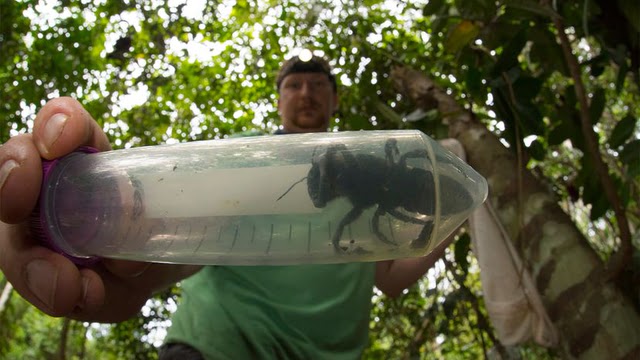Quck answer
The Wallace’s Giant Bee, also known as the “Raja ofu” or “king of bees,” is the world’s largest bee and was thought to be extinct for 38 years until it was rediscovered in Indonesia in 2019. The bee can grow up to 1.5 inches long with a wingspan of over 2.5 inches. It is known for its unique nesting behavior, building its nests in termite mounds and using its large mandibles to collect resin to protect its nest. The bee is listed as “vulnerable” on the IUCN Red List due to habitat loss and hunting for collectors.
Wild Animals

Entomologist and bee specialist Eli Wyman, in the Indonesian islands of the North Moluccas, found the first rediscovered specimen of Wallace’s giant bee (Megachile pluto). Clay Bolt
Approximately 285 million years ago, during a Permian floodplain, you might have encountered a griffinfly, an insect that resembles a dragonfly and is as big as a crow. The reason for its size was due to atmospheric oxygen, which was around 31-35% (compared to today’s 21%). It turns out that the amount of oxygen is the limiting factor for the size of insects.
Despite the fact that we no longer have dragonflies with 2-foot wingspans, there are some modern insects that stand out. Wallace’s giant bee (Megachile pluto), the world’s largest bee, is five times larger than the European honeybee, the size of an adult human’s thumb, and has large mandibles that are used to collect tree resin to line their nests. The bee was believed to be extinct since no one had seen it since 1981, and before that, since its discovery in 1858 by the English biologist, Alfred Russel Wallace. It is difficult to prove the existence of an organism if it cannot be found alive.
However, in January 2019, a team of researchers found the bee nesting in a termite nest on a tree trunk on a collection of small islands in Indonesia called the North Moluccas.
“It was incredible to see how beautiful and large the species is in life, to hear the sound of its giant wings thrumming as it flew past my head,” said Clay Bolt, a natural history photographer who captured the first photos and video of a live giant bee, in a press release.
Over the years, several research expeditions were conducted to locate Wallace’s giant bee, but they were unsuccessful until now. However, specimens were sold – one was auctioned on eBay in 2018 for $9,100. That is more than the average price of an insect corpse.
The exact island where the bee was found is undisclosed because if the researchers published that information, the remaining Wallace’s giant bees might be in danger.
Since the bee has only been seen a few times in the wild, little is known about its habits and life history, except that it prefers to live in termite nests in lowland forests. Indonesia lost 15% of its tree cover between 2001 and 2017 to make way for agricultural fields, so conservation efforts must be implemented soon to sustain the rekindled relationship with Wallace’s giant bee.
But for now, it’s good to know that Megachile pluto is still buzzing through the forest like a little helicopter. The giant griffinflies of the Permian would have liked that.
Now That’s Interesting
Expeditions to find other lost species are ongoing, such as the Pondicherry shark, the pink-headed duck, and the elusive Wellington’s solitary coral.
FAQ
What is Wallace’s Giant Bee?
Wallace’s Giant Bee (Megachile pluto) is the world’s largest bee, with a wingspan of up to 2.5 inches. This bee was first discovered by British naturalist Alfred Russel Wallace in 1858 and was not seen again until 1981. Since then, there have been only a few sightings of this elusive bee.
Why is Wallace’s Giant Bee so rare?
Wallace’s Giant Bee is rare because of its limited distribution. It is found only in the Indonesian islands of Bacan and Halmahera, where it lives in lowland rainforests. Habitat loss due to deforestation and agricultural development has also contributed to its rarity.
How was Wallace’s Giant Bee rediscovered?
Wallace’s Giant Bee was rediscovered in January 2019 by a team of international researchers led by American entomologist Clay Bolt. The team used a combination of natural history knowledge, hiking through dense forests, and setting up bamboo tubes as traps to locate and photograph the bee.
What is the significance of the rediscovery of Wallace’s Giant Bee?
The rediscovery of Wallace’s Giant Bee is significant because it provides an opportunity to study the bee’s biology and behavior. This information can be used to develop conservation strategies to protect the bee and its habitat. The rediscovery also highlights the importance of preserving rainforests and other natural habitats where rare and endangered species live.
Is Wallace’s Giant Bee endangered?
Wallace’s Giant Bee is considered endangered due to habitat loss and limited distribution. The bee’s rarity makes it difficult to assess its population status accurately, but the International Union for Conservation of Nature lists it as “vulnerable.”
Why is Wallace’s Giant Bee important to the ecosystem?
Wallace’s Giant Bee is an important pollinator in its rainforest habitat. Its large size and strong jaws make it an effective pollinator for certain flowers that smaller bees cannot access. The bee’s role in pollination helps to maintain the biodiversity of the rainforest ecosystem.
What threats does Wallace’s Giant Bee face?
Wallace’s Giant Bee faces threats from habitat loss due to deforestation and agricultural development. The bee is also hunted for its large size and rarity, which makes it a valuable specimen for collectors and traders.
What can be done to protect Wallace’s Giant Bee?
To protect Wallace’s Giant Bee, conservation efforts should focus on preserving its habitat through forest conservation and restoration programs. The bee should also be protected from hunting and trade through regulations and enforcement efforts. Research on the bee’s biology and behavior can help inform these conservation strategies.





Leave a Reply